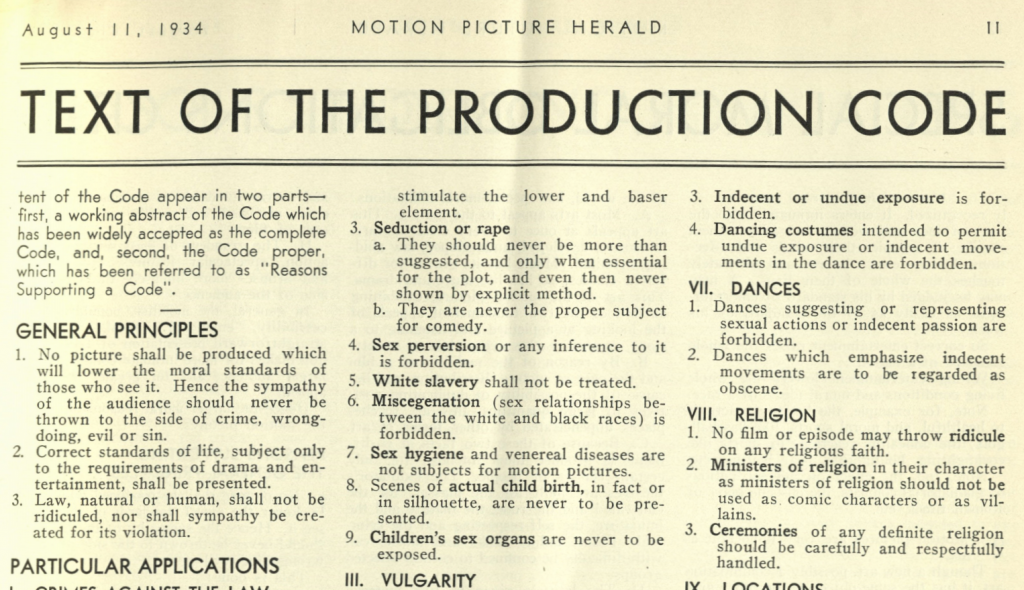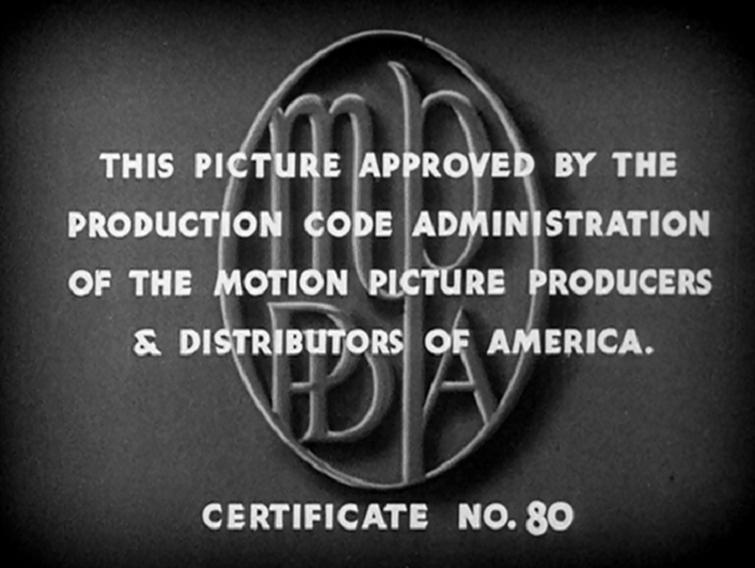Sex perversion. White slavery. Childbirth. Miscegenation. Obscenity. Salacious titles. These are just a few of the subjects that were forbidden by the “Production Code” that governed Hollywood on-screen morality from 1930 through 1968. It’s been a challenge to find a good summary of the changes in the Code, so included here are links to original sources as well as a downloadable quick-guide I created showing the three major changes to the code before it was strictly enforced in 1934.

History of the Code

There are many books, websites, and Wikipedia articles about the Production Code, but I thought it would be helpful to give some context to my quick-guide.
Film censorship in America had fits and starts across different states from early in its history, but in 1922, the major film studios finally managed to form a lasting trade association: The Motion Picture Producers and Distributors of America (MPPDA, changed to MPAA in 1944, and MPA in 2019 – dropping “America” now that it is more international). The main focus of the MPPDA in its early years was on producing a strong public relations campaign to ensure that Hollywood remained financially stable and able to attract investment from Wall Street, while simultaneously ensuring that American films had a “clean moral tone.” Presbyterian deacon, former chairman of the Republican National Convention and U.S. Postmaster General, Will H. Hays was hired as the first president of the MPPDA.
As far as I can tell, the MPPDA established a gentleman’s agreement with production companies regarding book and play adaptations, approved June 19, 1924.* Full text is in this PDF, but here are the key points (emphasis added):
The [MPPDA is] engaged in a special effort… to avoid the picturization of books or plays which can be produced only after such changes as to leave the producer subject to a charge of deception; to avoid using titles which… by their suggestiveness seek to obtain attendance by deception; … and to prevent misleading, salacious or dishonest advertising.
Resolution passed by the MPPDA on June 19, 1924
“The Formula,” as it was known but apparently unpublished, was similar to the “Thirteen Points” established by the National Association of the Motion Picture Industry (NAMPI) in 1921 [PDF]. See Kia Afra’s 2016 book The Hollywood Trust for details about the politics of these trade associations. For a good overview of the codes and rating system (which replaced the Code in 1968) through 1990, read Where Do Film Ratings Come From? on The Beat – there’s also a video.
The documents
I’ve tried my best to be as accurate as possible with these original sources, as everyone seems to have their own opinion about how the Code was developed and published over the years. Copies on the web claim to be from a certain year, but they’re often sourced incorrectly. You can download these, as well as the spreadsheet below, in bulk from Dropbox.
Don’ts and Be Carefuls – Resolved at the Quarterly Directors’ Meeting of June 29, 1927 [PDF] and implemented in October as a way to review scenarios and finished films. [HTML text from theFIRE.org]
A Code to Maintain Social and Community Values in the Production of Silent, Synchronized and Talking Motion Pictures – Resolved March 31, 1930 [PDF]. [Pamphlet] [Exhibitors Herald trade paper coverage]
A Code to Govern the Making of Motion and Talking Pictures: the Reasons Supporting It and the Resolution for Uniform Interpretation – Amended June 13, 1934 [PDF], but no copy of the actual code from the MPPDA at that time. The Motion Picture Herald trade paper coverage, August 11th [PDF] contains the full text (identical to the 1930 version) and shows the newly-added “reasons supporting a code” at the end, which expound upon the code, point by point [HTML text from ilianFilm]. (The “reasons” piece was debated in 1930, but not officially released to the public until 1934.)

Comparison of changes
And now for the real reason I created this post: a quick view of the codes to give you an idea of what was regulated until 1968. Below, I’ve embedded a Google spreadsheet showing the 1921, 1927, and 1930 codes, simplified side-by-side. The underlined items in red were dropped in the 1930 code. (Also available in printable PDF or XLSX form on Dropbox.)
Resources
- The Production Code of the Motion Picture Industry (1930-1967) – David P. Hayes has created an impressive site that shows the changes in the code between 1934 and 1967. His comment about differences in the 1930 and 1934 texts doesn’t appear to be correct – they’re identical except for the addition of the Reasons in 1934.
- List of MPAA Film Numbers [PDF] – Specific certificate numbers for tens of thousands of films, from 1930 to 2014 (so far).
- Special thanks to Richard Maltby, whose personal correspondence helped me clarify how the code was published. His chapter, “The Production Code and the Hays Office,” from Grand Design: Hollywood As a Modern Business Enterprise, 1930-1939 (1993) is particularly well-researched.
* Please let me know if you have any primary sources for “The Formula.”
Leave a Reply